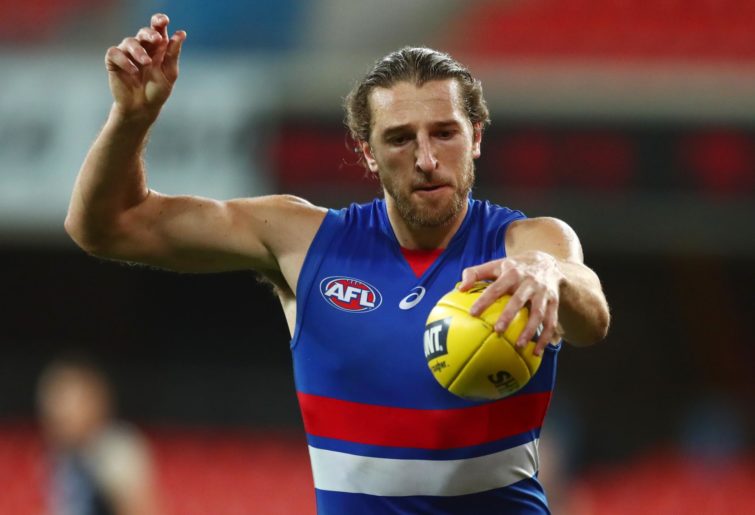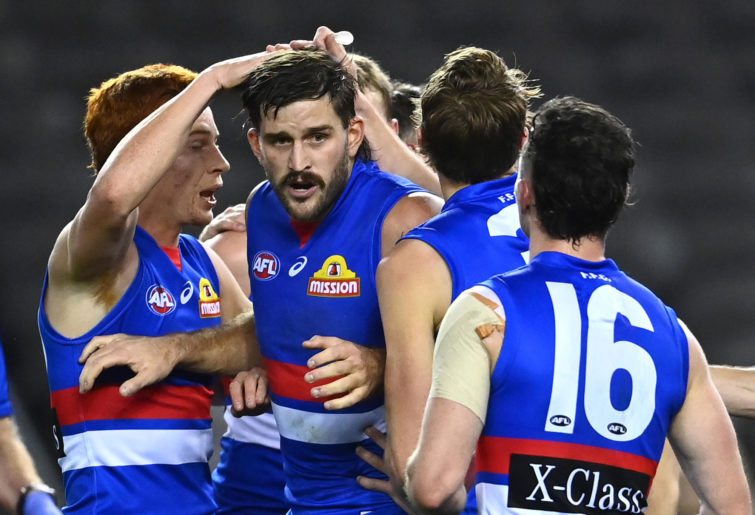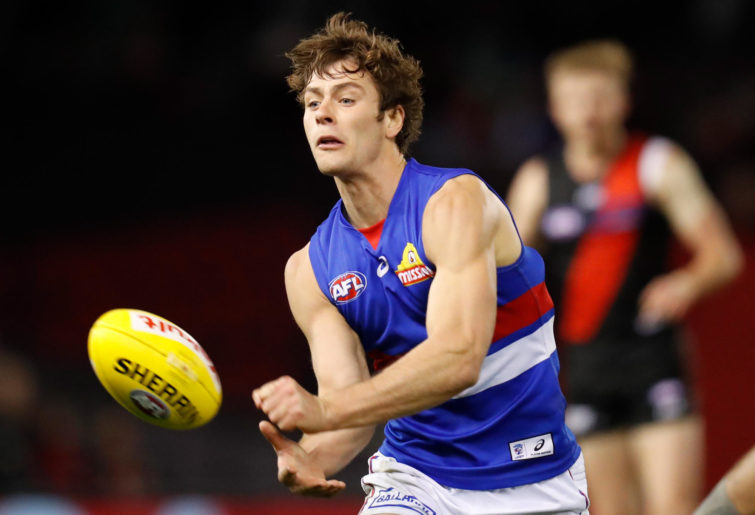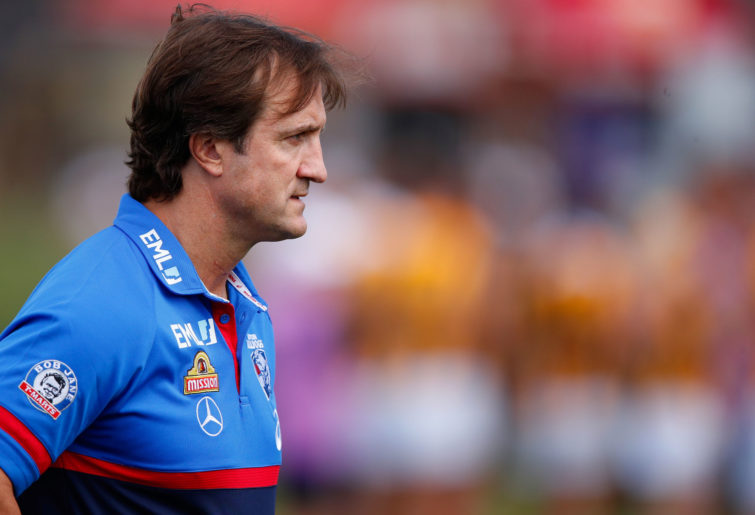WATCH: 'He's confused' - Anthony Caminiti's woeful snap from close sums up St Kilda's night
A set shot from that distance, you'd expect him to goal, but nothing was going the Saints' way.
Opinion
The Western Bulldogs are one of the league’s greatest enigmas.
No team rides momentum better than the Bulldogs, nor does one claim the title of perennial dark horse belongs anywhere else other than the boys from the West.
After an elimination final loss to St Kilda, the Dogs finish the season with an overwhelming feeling of ‘almost, maybe, not quite’.
Having made finals, there was no danger of facing ignominious failure.
But coming out of 2020 with a home-and-away record of one win and six losses against fellow finalists with a percentage of 66.67 followed by an immediate loss in the finals, perhaps the top-eight finish disguised what was an otherwise disappointing season.
Let’s break the Bulldogs’ 2020 down.

(Photo by Robert Cianflone/Getty Images)
The good
The positives tend to stem from individual performances that range from encouraging to outstanding.
An overarching acknowledgement of the quality youth in this team is important given key players will be around for at least the next seven seasons, thus offering the Bulldogs a strong future.
The 2020 season was more than emergence for Mitch Wallis in his forward role, kicking 25 goals to lead the team comfortably in the metric.
The nature of the season saw the 27-year-old receive plenty of attention fairly swiftly, but he still performed to a high level and proved himself to be one of the strongest one-on-one players in the league.
Laitham Vandermeer too deserves to be spoken of.
Even when he had a quieter game the 21-year-old still popped up to be relevant, showing a knack for turning up in the right spot at the right time, even if he couldn’t quite nail the execution in his first season of senior footy.
Catching many off-guard with his debut, Vandermeer showed an ability to work hard and play anywhere along the outer wing, particularly showcasing some good traits when Lachie Hunter was unavailable for selection.
He averaged 10.5 disposals, 2.8 marks, 2.4 tackles and 2.9 inside 50s in his 11 full games, kicking nine goals and nine behinds off a half-forward flank and advanced wing position.
And the stride forward Marcus Bontempelli took a captain was a key reason that the Bulldogs made finals.
There is of course intangibility surrounding the notion of leadership, but the Bulldogs have been blessed with captains who can maximise that physical unknown and turn into hunger and desire.
Bontempelli’s numbers carry much more weight than Bob Murphy or Easton Wood, but the camaraderie and passion that is shown for the Bulldogs is cut from the same cloth as his predecessors.
Statistically, though, this was an excellent and perhaps more consistent season than we have seen from the 24-year-old.

(Photo by Chris Hyde/Getty Images)
Ranked top ten in the league for tackles, clearances and inside 50s as well as in the top 15 for score involvements, goal assists and metres gained, Bontempelli’s well-rounded game ensured he had a lasting impact on the team in multiple categories.
In many ways Bontempelli’s output created an opportunity for Bailey Smith to take a huge step forward, which he was able to.
Smith himself was top 20 in the AFL for disposals and ranked 15th for inside 50s, really thriving in an attack-minded role rather than the two-way approach displayed by others.
This wasn’t needed from Smith in his role, but it will be encouraging to see that side of him develop as he gets more time in the senior system under his belt.
Of course there was the step up to elite status for Caleb Daniel, the reliability and consistency of Bailey Williams, the typically underrated but strong season from Tom Liberatore and the spurts of brilliance from Tim English that many Bulldogs fans will hold onto as lasting lessons out of the season.
But for the most part these were all areas that we already knew about that had seen success.
For Wallis’s emergence, Tory Dickson had played the same role a few years earlier.
The midfield has always been an on-paper strength of the Bulldogs, so it’s unsurprising that some strong performers emerged as positives from throughout the season.
Which is why the uglier parts of the game warrant a far larger focus.
The ugly
There was nothing really that bad from the Bulldogs this season to warrant a title of this nature other than the aforementioned record against top-eight teams.
Those performances were ugly in nature, with an average losing margin of five goals against top teams throughout the home-and-away season, and they reeked of a team experiencing some sort of disconnect on the ground.
The forward line, outside of Wallis, was a mess.
Josh Bruce drew a lot of criticism this season, a lot of which has been justified as one of the two big recruits specifically brought in to fix the issues that had been obvious.
Goalless on nine occasions during 2020 and finishing with two kicks or less in six matches, the output was poor, but placing criticism on one player isn’t fair.
Bruce simply isn’t a main target in attack, which was the role he had to play for half the season with Naughton injured.
He is not the pack-bursting monster option the Bulldogs and their fans needed him to be but rather the lead-up type who can outwork his opponent and subsequently find space inside 50.
Bruce needing to change his game so early into his time at the new club led to issues down the line when Naughton was able to return.
It became increasingly obvious, and indeed was a factor against the Saints in the elimination final, that the two players kept getting in each other’s way.

(Photo by Quinn Rooney/Getty Images)
A perfect 2020 would’ve seen Naughton play deep and launch at the ball while Bruce could play off that by using dummy leads to create space or use the intelligent angles he would run at St Kilda to lead up into more space in the opposite pocket.
Instead long balls in saw Bruce and Naughton compete for the same ball in way too many contests, and with an over-reliance on midfield types to crumb it just didn’t end well for the Bulldogs.
That lauded midfield depth in itself caused issues in these types of situations when players like Dunkley, Liberatore, Bontempelli, McLean pre-injury and a little bit of Lipinski were the ones needing to rove packs.
All are excellent players who can do it. The issue is that they shouldn’t need to.
In a final there shouldn’t be a reliance on Roarke Smith to provide the forward half service and follow up when the player is more naturally suited to open space and plenty of the field ahead of him.
The abundance of midfielders, wingmen and flankers caused the Bulldogs to trip up way too much in 2020 and should hopefully be a wake-up call.
An Ed Richards hasn’t been suited to much of the team’s way of playing this season given his ad hoc positioning, which has stunted his development a little.
And while all of that was certainly a mess, the defence is where it was perhaps the ugliest.
You need look no further than the elimination final, where the Bulldogs conceded 21 contested marks, almost all in attack and an astonishing four to Jarryn Geary.
The other tall signing alongside Bruce was Alex Keath. Immediately it seemed obvious he wasn’t the type of player the Bulldogs desperately needed to stop aerial dominance from the opposition, and it played out that way.
Keath’s best footy came as the third key defensive option, where he could use his intercepting and elite reading of the play.
In 2020 he was more often than not the Bulldogs’ main key defender, which didn’t help anyone.
Against the Saints better one-on-one players were able to stand tall and take the marks, leaving him with nowhere to go.
It wasn’t that he had a bad season overall – Keath performed admirably for a player in a rather unknown role.
His numbers were average at best, however, and what’s worse is it affected his ability to peel off, which resulted in below-average possession and rebounding numbers.

(Photo by Michael Willson/AFL Photos via Getty Images)
The combination of the more defensive duo of Zaine Cordy and Ryan Gardner should’ve helped him out but ultimately didn’t.
Cordy’s numbers were solid and his injury really hurt the Bulldogs against St Kilda, although given his size he wasn’t about to stop the contested marking.
And Gardner copped a lot of flak throughout the season but was persisted with and at least looked more comfortable as the season wore on.
The 23-year-old has the size the Bulldogs needed this season and he had a crack with what he had, but at the time it wasn’t enough.
The Bulldogs were opened up way too easily in defence many times throughout the season, which leaves a concerning thought that the obvious aspect that needed to be fixed was somehow made worse as a team structure.
It’s hard to say the team was bad defensively, because there were some games where Keath was fantastic and it had a flow-on effect to the rest of the back six.
More evidently in the losses, however, was how ugly the mismatch of defensive traits and understanding of positioning was.
Perhaps that is why the Bulldogs had a lot of ugly areas in their style this season.
Momentum can be a mirage if it doesn’t take you to the promised land. When the Bulldogs were riding that wave, it didn’t appear as though there were any cracks. And when it all settled down, there wasn’t enough Seeley’s to go around.

(Photo by Michael Willson/AFL Photos via Getty Images)
The response
The 2020 season turned out uglier than anticipated and was perhaps the most confusing of the last couple of seasons. Ultimately, it was hard to actually define the Bulldogs’ style other than their ability to get on a roll.
The beauty of talented youth, however, is that it shouldn’t take much for the Bulldogs to be a top-four threat in 2021.
It’s hard to assume a more conventional mindset will be adopted by the coach, but that’s part of Luke Beveridge’s allure. He has, however, earmarked significant changes to the best 22 and highlighted that things must change, which is a step in the right direction.
Driven by opinion rather than speculation, there are a couple of things the Bulldogs should look at.
The recruitments of Josh Bruce and Alex Keath were a failure but only in the sense that they were not the right fits for the roles they filled. Both still have a role to play and should be better off in 2021 if the Bulldogs look after them.
With Jamarra Ugle-Hagan joining the club, the Bulldogs have an electrifying key-position talent they can rely on going forward. The most interesting point of discussion will be to see if he is used immediately in at senior level or given a little time to develop.
Regardless, the number one target at the Bulldogs should be Todd Goldstein. While there were excellent signs in the ruck in highlights from Tim English, he was almost exclusively beaten in the actual ruck and relied on his worked around the ground to boost his performance.
His reading of the play helped the Bulldogs defence earlier in the season, while his contested marking and forward positioning made him a threat late.

Bulldogs coach Luke Beveridge (Adam Trafford/AFL Media/Getty Images)
By recruiting Todd Goldstein, multiple doors open for the Bulldogs. First, they’d be giving English the best possible mentor to help develop him into a better ruckman. Then there’s the flow-on effect, which would allow English to play a lot more forward as St Kilda did with Rowan Marshall and Paddy Ryder this season.
English’s hands are at an elite level and his height and athleticism could easily see him average over a goal a game as well as his ability to push higher up the ground.
The Bulldogs have greater flexibility available to them with English in attack.
Regardless of what they choose to do with Ugle-Hagan, the Dogs should move Naughton into defence and let him settle there.
The Bulldogs become a far stronger defensive unit with some aerial coverage, and there’s no reason why Naughton cannot study tapes of Darcy Moore and emulate his output with better hands.
They could also keep Naughton in attack alongside English and really give Bruce free rein on the lead, which would give him the opportunity to prove a lot of people wrong, although Josh Schache could play the role of Naughton.
With Goldstein the ideal target in the off-season, perhaps another can be Aliir Aliir.
The Swan has fallen victim to being thrown all over the place when just two seasons ago he was emerging as one of the best young key defenders in the league with really good one-on-one work and great closing speed on the lead.
In 2018 Aliir averaged 16 disposals and eight marks a game as a key defender who used his strength when required and took control of the intercepting game.
Going down this path allows Keath some freedom and lets Cordy act as the third tall, deserving of the opportunity to continue in the best team after some really strong performances, or Naughton could still make the positional move and form a strong partnership.
We could list seemingly attainable targets like Peter Wright and Tom McDonald, and the former could be a nice selection, but in targeting Goldstein and Aliir along with the drafting of Ugle-Hagan the Bulldogs would actually address key issues.
Ultimately this looking to top up with a couple of shrewd yet necessary moves to actually strengthen the deficiencies that were highlighted in 2020 for the Bulldogs.
That might be all it takes for the perennial dark horse to become the perennial premiership contender.